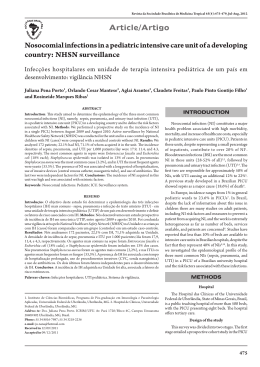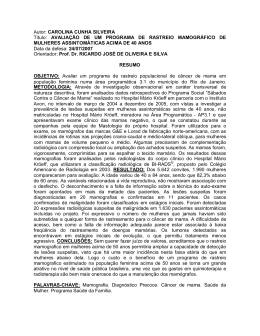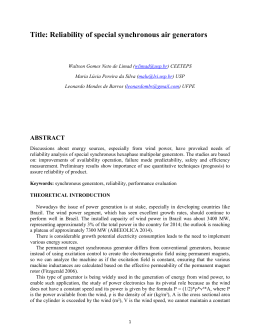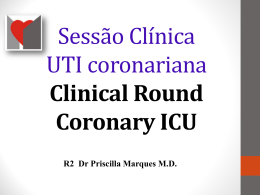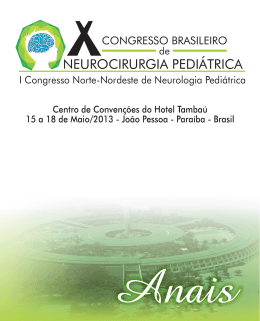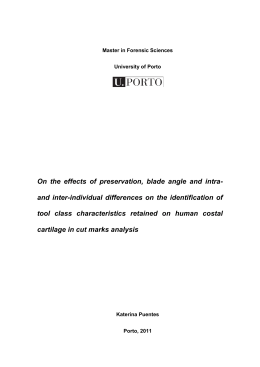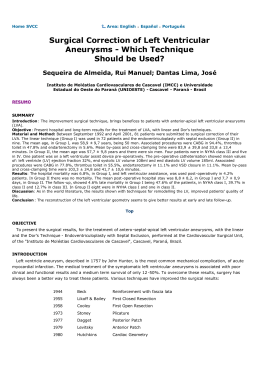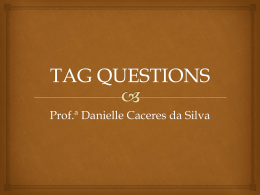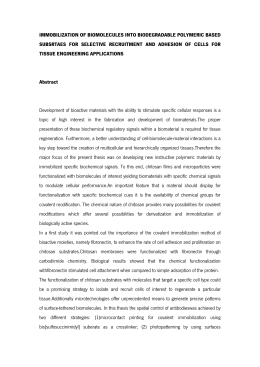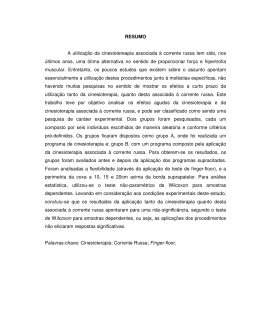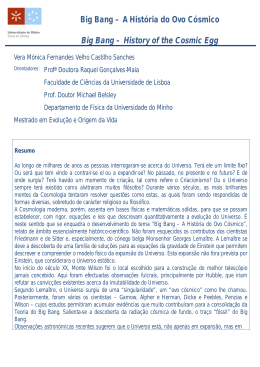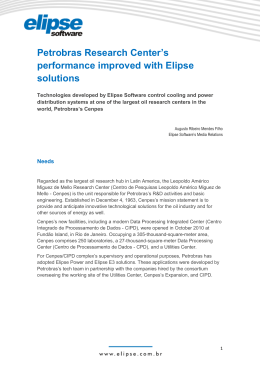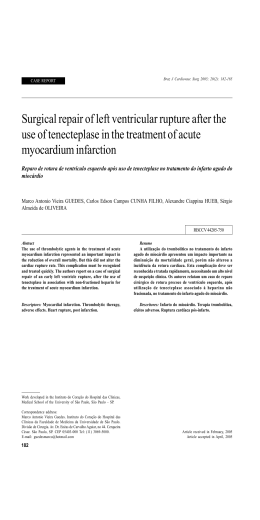Home SVCC Area: English - Español - Português Physiological Programmability in Artificial Pacemakers Almeida Rui, Manuel Sequeira; Lima Jr., José Dantas. Instituto de Moléstias Cardiovasculares de Cascavel (IMCC) e Universidade Estadual do Oeste do Paraná (UNIOESTE), Cascavel, Paraná, BRASIL RESUMO SUMMARY Objective: To verify the benefits given by all the parameters and programmable functions of the artificial pacemakers (AP), that give a more physiological stimulation and appropriate to the patient's necessities, which depends on the knowledge and use of the functions and parameters given by the pulse generators. Material and Method: Twenty-five patients were studied (13F/12M), with AP with a mean age of 62.9 years, for a period post implantation of 12.4 months. The indication for AP implant was in all cases complete atrioventricular block. All generators had movement sensors. Two evaluations were performed in the post implant period. On the first one, with the basic program, a verification of the following parameters was performed: electric parameters, myopotential inhibition, statistic within the generator and the advanced programs. On the second evaluation the changes made to the original program, and the percentage of events sensed and stimulated by the AP were analyzed. Results: The P and R waves, ventricular threshold and impedance values obtained at the first evaluation, were respectively: 1.50±1.85 mV, 12.55±4.35 mV, 0.76±0.29 V, 530.64±93.27 ohms. Two pulse generators were in VDD mode, eight in VVI and 15 in VVIR. The night program was always on, with a mean duration of 7.2 hours. In 13 AP, with a unipolar lead, there was myopotential inhibition and the sensibility was reduced. The statistical data, during the basic program showed that 19.4% were sensed events (SE) and 80.6% were paced events (PE). During the advanced program, the percentage of SE was 23.4% and the PE was 76.6%. Conclusion: The change in the original pulse generator program done in these patients, presents benefits within the physiological rhythm, therefore having a smaller competition with the spontaneous activity and showed a reduction in PE. With these in mind we conclude that these pulse generators should have a greater longevity. Top INTRODUCTION Although we don't have a national industry, of artificial pacemakers, we have almost all the worldwide manufacturers working here in Brazil nowadays, therefore we have innumerable models of leads and generators available to satisfy our needs. The manufacturer or the standard programming, of the generators, rarely attends the needs of our patients. In the majority of the cases the generators programming adjust is individualized and depends on a more detailed follow-up including especially the statistic functions. The enterprises that present in Brazil the same products commercialized in the origin countries have these statistic functions very developed and confident. The objective of this study is to check the benefits provided by an adequate and large pacemaker programming, and that provides a physiologic response approach of the patients. Among these parameters, will be evaluating stimulation mode, basic rate, hysteresis, night program, sensor for frequency adaptation and others. BASIC PROGRAMMING The basic programming refers to the standard program that goes along with the pacemaker when it is implanted and during the acute phase. EXTENDED PROGRAMMING The extended programming is realized when the scar process is considered chronic or the variations that will occur will not be significant. In these moment the electric parameters and the pacemaker statistic are checked and, based on these information, the pacemaker is programmed ( Figure 1 ). Fig. 1: Basic programming (PREV.) and extended programming (NEW) MATERIAL AND METHODS At the "Instituto de Moléstias Cardiovasculares de Cascavel", 25 patients (13 F/12 M) with artificial pacemaker, implanted between October of 1999 and August of 2000, with an mean age of 62.92 ± 17.78 years, were studied during a postoperative medium period of 12.48 ± 5.03 months. The implant indication in all the cases was complete heart block. All the implanted generators had movement sensor (accelerometer). Among these pacemakers, 23 were ventricular single chamber and two were dual chamber with single lead. Two follow-ups were realized in the postoperative period with the system PMS 1000 (Biotronik GmbH & Co.). In the first follow-up, with the basic programming, we checked: the electric parameters, the myopotential inhibition, the statistic contained in the generator memory and the extended programming was activated. In the second follow-up we checked the statistics results with the extended programming. In these second follow-up we analyzed: the changes done in the programming and the percentage of sensed and paced events by the pacemakers. RESULTS The mean values of P and R wave, ventricular stimulation threshold and impedance, checked in the first follow-up, were respectively: 1.50 ± 1.85 mV; 12.55 ± 4.35 mV; 0.76 ± 0.29 V; 530.64 ± 93.27 Ohms. The stimulation mode of the two dual chamber generators with single lead remained in VDD (8%). From the 23 ventricular single chamber generators, 8 remained in the mode VVI (32%) and 15 were programmed in the mode VVIR (60%). In all the cases the night program was activated with a medium duration of 7.20 ± 0.69 h. The hysteresis was activated in one case. In six cases the basic frequency was reprogrammed. In the cases (six) that the implanted lead had two poles, the sense and pace polarity was programmed to bipolar. In 22 cases the generators sensibility was reduced. In 13 (68%) pacemakers, with unipolar lead occurred myopotential inhibition. During the R wave test, five patients (20%) were considered dependents (didn't show ventricular intrinsic beats with a frequency as low as 30 bpm), four patients (16%) showed intrinsic beats between 30 and 40 bpm, six patients (24%) showed intrinsic beats between 40 and 50 bpm, two patients (8%) showed intrinsic beats between 50 and 60 bpm and eight patients (32%) showed intrinsic beats with a frequency, higher than 60 bpm. The statistics data during the basic programming showed that 19.4% were sensed events (Vs) and 80.6% were paced events (Vp). During the extended programming, the percentage of Vs was 23.4% and Vp 76.6%. DISCUSSION One of the patients with dual chamber generator and single lead, showed atrial undersensing and far-field. We had to increase the atrial sensibility despite the far-field. However, no alteration in the rhythm occurred due to this interference because it was contained inside the atrial refractory period. No patients with VDD programming showed cross-talk. The activity sensor, or accelerometer, was activated in patients that didn't show myocardiopathy, were active and related tiredness after efforts, and demonstrated high stimulation percentage (> 80%) in the pacemaker event counter ( Figure 2 ). Fig 2: Pacemaker event counter Despite these parameters being activated in the extended programming, in 60% of the patients, there was an increase of 4% in the sensed events total medium value, and a proportional reduction in the stimulation. This compensation, obviously, occurred because of the night program activation that reduced on average 10 ppm in the basic rate during a medium time interval higher than seven hours (29%). The average high age (62 years) also could contribute for this compensation, because the activity level in advanced ages decay. In the case of night activity in patients without any chronotropic response the accelerometer will answer, but with a minor sensibility. We can have an idea of the alterations caused by the extended programming in the Figures 3 and 4. Fig 3: Basic (up) and extended programming histograms Fig 4: Basic and extended programming 24 hours monitor The test to verify the myopotentials interferences appeared extremely important, due to the fact that 68% of the patients with unipolar leads showed myopotentials interferences in the standard sensibility (2.5mV). The patient was monitored in a peripheral derivation opposite of the generator implant (D3 and D2 for those with right and left side implants, respectively). Movements of the arm activated pectoral musculature, in the side of the generator. In the case of interference the sensibility was reduced until the complete elimination of the interference. The safety margin maintained in the sensibility programming was always higher than 100%. CONCLUSION The programming achieved in the studied patients showed the inherent clinical benefits to the physiologic rhythm, allowed a minor competition with the spontaneous activity and showed a reduction in the stimulated events percentage. Therefore, we presuppose an increase in the generators battery longevity and, consequently, a higher period without the exchange of the generator necessity, with advantages for the patient and the contribution to the costs reduction with these devices. Top Programação Fisiológica em Marcapassos Cardíacos Artificiais RESUMO Objetivo: Verificar os benefícios proporcionados pelos diversos par âmetros e funçõ es programáveis dos marcapassos cardíacos artificiais (MCA), que propiciam uma estimulação mais fisiológica e apropriada às necessidades dos pacientes, o que depende do conhecimento e uso das funçõ es e parâmetros disponíveis nos geradores. Material e Método: Foram estudados 25 pacientes (13F/12M) portadores de MCA com média de idade de 62,9 anos por um período médio pós-implante de 12,4 meses. A indicação de implante em todos os casos foi BAVT. Todos os geradores implantados apresentavam sensor de movimento. Realizaram -se duas avaliações no período pós-implante. Na primeira avaliação, com a programaçã o básica, foram verificados: os parâmetros elétricos, a inibiçã o por miopotenciais, a estatística contida na memória do gerador e ativada a programaçã o estendida. Na segunda avaliaçã o verificou-se o resultado da estatística com a programação estendida. Foram analisadas: as mudanças feitas na programação e o percentual de eventos sentidos e estimulados pelos MCA. Resultados: Os valores médios da onda P, onda R, limiar de estimulação ventricular e imped ância, verificados na primeira avaliação, foram respectivamente: 1,50±1,85 mV, 12,55±4,35 mV, 0,76±0,29 V, 530,64±93,27 ohms. Dois geradores ficaram em VDD, oito permaneceram no modo VVI e 15 foram programados no modo VVIR. O programa noturno foi sempre ligado com uma dura ção média de 7,2 hs. Em 13 MCA com eletrodo unipolar ocorreu inibiçã o por miopotenciais e a sensibilidade foi reduzida. Os dados estatísticos durante a programaçã o básica mostraram que 19,4% foram eventos sentidos (Vs) e 80,6 % foram eventos estimulados (Vp). Durante a programaçã o estendida, o percentual de Vs foi de 23,4% e Vp de 76,6%. Conclusão: A programação realizada nestes pacientes apresenta os benef ícios cl ínicos inerentes ao ritmo fisiol ógico, permite uma menor competiçã o com a atividade espontânea e mostra redução no percentual de eventos estimulados. Com isto pressupomos um incremento na duraçã o da vida útil da bateria dos geradores. Top Your questions, contributions and commentaries will be answered by the authors in the Arrhythmia mailing list. Please fill in the form (in Spanish, Portuguese or English) and press the "Send" button. Question, contribution or commentary: Name and Surname: Country: Argentina E-Mail address: @ Send Erase Top 2nd Virtual Congress of Cardiology Dr. Florencio Garófalo Dr. Raúl Bretal Dr. Armando Pacher Steering Committee President Scientific Committee President Technical Committee - CETIFAC President [email protected] [email protected] [email protected] [email protected] [email protected] [email protected] Copyright© 1999-2001 Argentine Federation of Cardiology All rights reserved This company contributed to the Congress:
Download
